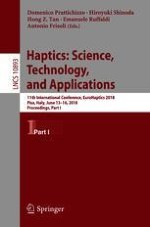2018 | OriginalPaper | Chapter
Influence of Different Types of Prior Knowledge on Haptic Exploration of Soft Objects
Authors : Aaron Cedric Zöller, Alexandra Lezkan, Vivian C. Paulun, Roland W. Fleming, Knut Drewing
Published in: Haptics: Science, Technology, and Applications
Publisher: Springer International Publishing
Activate our intelligent search to find suitable subject content or patents.
Select sections of text to find matching patents with Artificial Intelligence. powered by
Select sections of text to find additional relevant content using AI-assisted search. powered by
